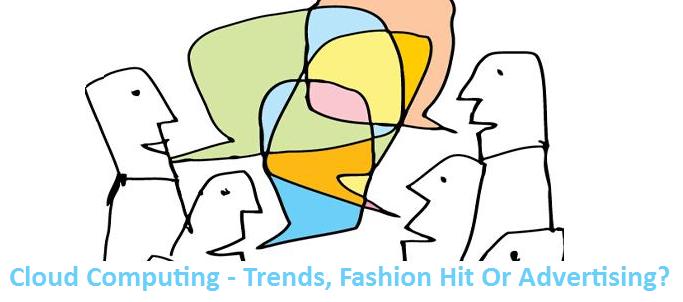Cloud Computing – Trends, Fashion Hit Or Advertising?
 Many IT professionals adopt Cloud Computing as it is extremely innovative and new, while some still do not know what is good, others are better informed and others go in the excitement of the moment, which is shaking the market. The truth is that, some concepts of the Cloud Computing technology are already on the market for some time. For example, the basic concept itself is not very different from the concept of mainframes, where terminals are accessed through an application or system existing in the same mainframe, just as we have customers in Cloud Computing (usually using the browser) that will access the applications in the “cloud”. Computing in the Clouds utilizes virtualization technology, which was already being applied before on dedicated servers and mainframes in enterprises. Grid computing is also a feature of Cloud Computing that existed before, widely known for its use in various projects.
Many IT professionals adopt Cloud Computing as it is extremely innovative and new, while some still do not know what is good, others are better informed and others go in the excitement of the moment, which is shaking the market. The truth is that, some concepts of the Cloud Computing technology are already on the market for some time. For example, the basic concept itself is not very different from the concept of mainframes, where terminals are accessed through an application or system existing in the same mainframe, just as we have customers in Cloud Computing (usually using the browser) that will access the applications in the “cloud”. Computing in the Clouds utilizes virtualization technology, which was already being applied before on dedicated servers and mainframes in enterprises. Grid computing is also a feature of Cloud Computing that existed before, widely known for its use in various projects.
Can one then say that Cloud Computing is a publicity stunt? Not at all. However some companies may be taking advantage of all this enthusiasm about this technology to promote their products. Namely changing the terminology of their SaaS (Software as a Service) products for Cloud Computing. Some industry professionals also say that the confusion around what cloud computing really is fostered by several companies as a way of trying to better sell their products & cloud computing is “everything” and would not have any effect unless there is the change in nomenclature in some of the commercials.
I think Cloud Computing is not just a technology, but a collection of technologies used together and thus forming the Cloud Computing (hence perhaps the confusion regarding the term), and the concept that lies behind this revolution dates back 60 years, when John McCarthy opined that computing could be organized as a public utility (just like the grid power, for example). To use a machine and plug it into the mains you do not need to know how is the generation and distribution of energy, not knowing the technology associated with it. This same idea is what you want to bring Cloud Computing to Information Technology.
Cloud Computing can be seen as virtualized resources (either storage, operating systems or dedicated servers), through which we can use power storage and scalable and elastic processing, with redundancy. For example, we are accessing storage through the “cloud hosting” which can be distributed across multiple servers, and the contracted space may grow or shrink according to customer needs. Likewise we can have a virtual server (also distributed across multiple physical servers), which increases or decreases its processing power, according to the use we need.
In reality the client only need to define what you really need: whether it is a software ( SaaS ), a server ( IaaS ), platform ( PaaS ), development tools ( DaaS ) and communication services ( CaaS ) and will pay only for what you use, with the advantage by using just a browser where the operating system does not matter.
The fashion today is Cloud Computing, it may be that the name will change or new concepts will emerge, but it is certainly one of the trends of the future of information technology. There are, of course, security concerns about the data “in the cloud” and perhaps in some circumstances this technology should not be applied – after all, if you do not have an Internet connection or a VPN, you will not advance anything – but these certainly present difficulties will be resolved with the passage of time and as the concept of cloud computing evolves.
- How Cloud Computing Is Changing The Labor Market - March 25, 2015
- Adopting Infrastructure as a Service Can be a Good Deal - March 17, 2015
- Will Virtualize? Take These Six Points Into Consideration - March 12, 2015
